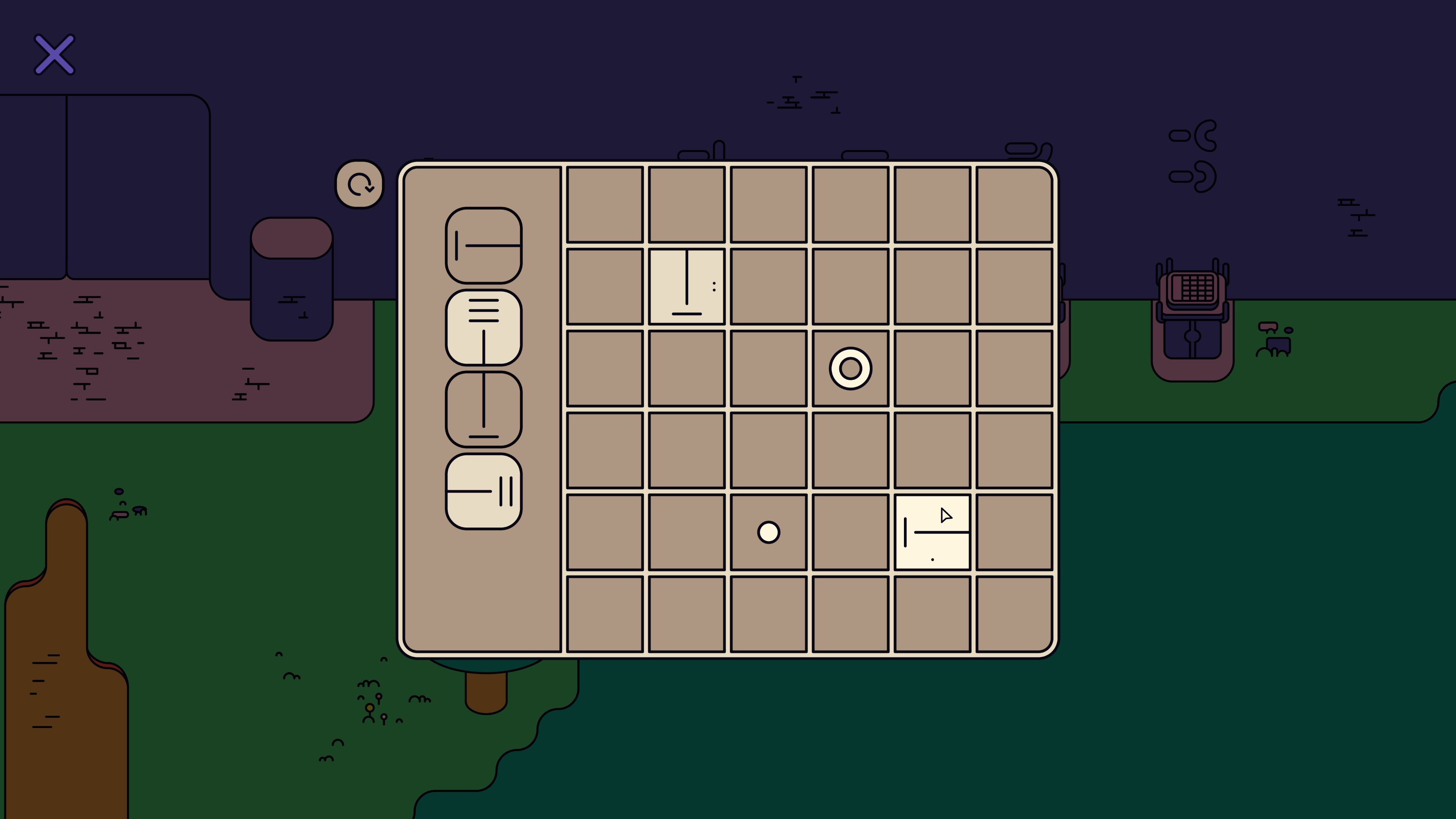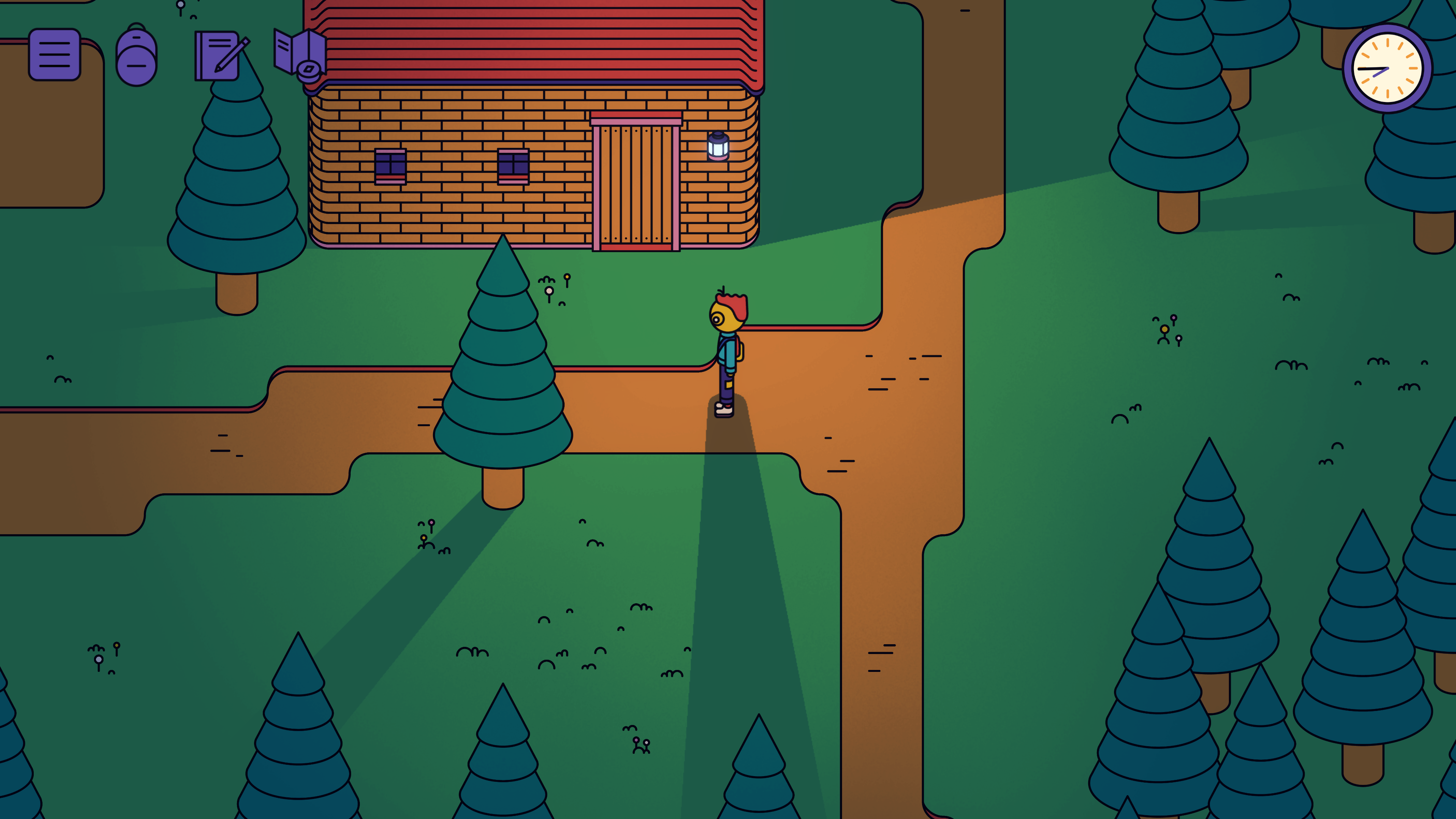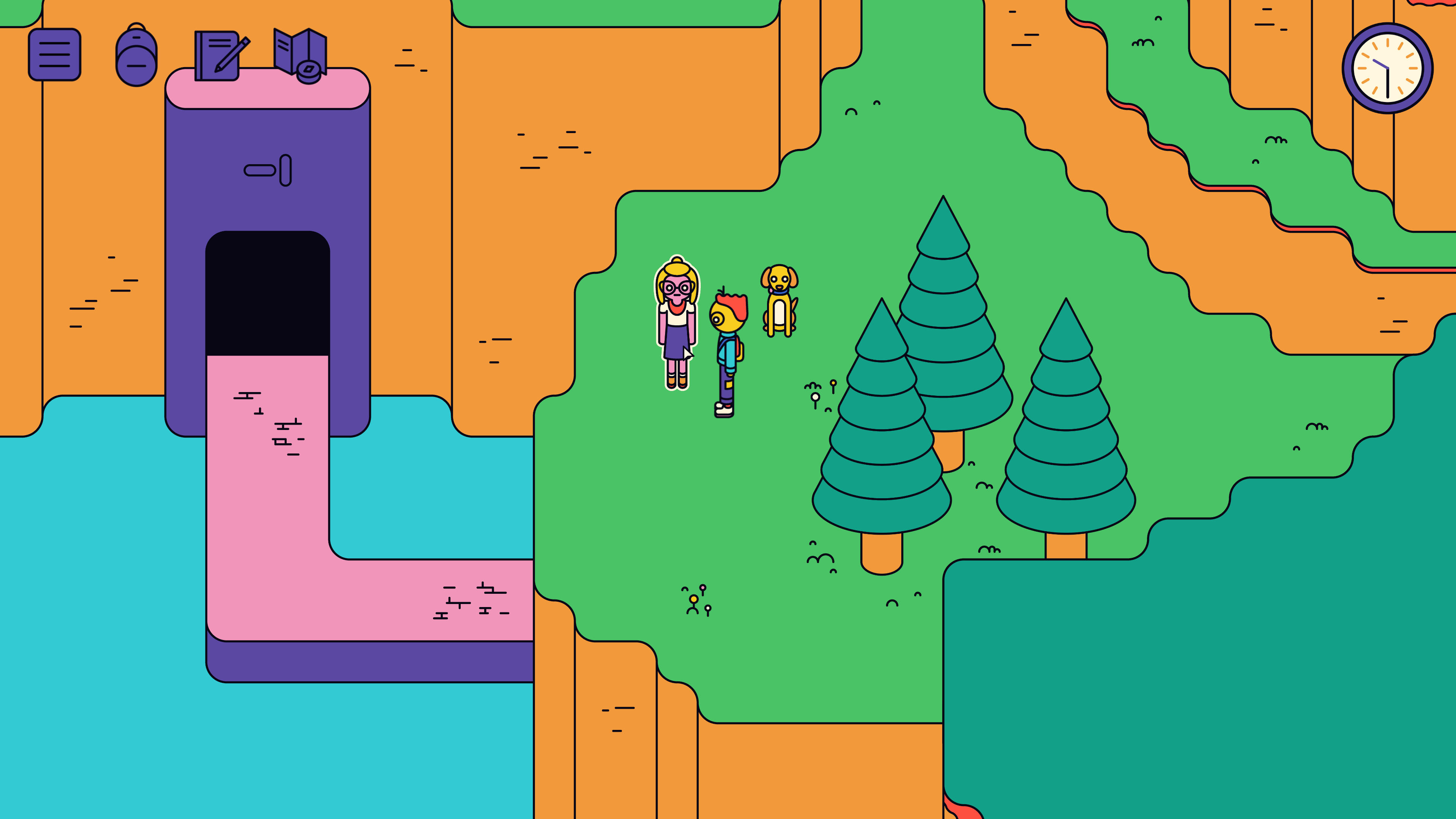








HELLO AGAIN
Designed and created by Dwight DavisItch.io Page (June 2022 Prototype Build)
Full Design Documentation
Steam Page
OVERVIEW
Hello Again is a time-looping adventure game set on an island filled with ancient ruins. Explore the island, solve time-bound puzzles, and interact with quirky characters to uncover the island's secrets and break the loop.DETAILS
- Team: Dwight Davis (solo developer)
- Genre: Adventure puzzle game
- Timeline: June 2021-Present (10+ hours/week, 793+ total hours)
- Software: Unity, Adobe Illustrator (artwork), FL Studio (music), Google Docs (planning)
GOALS
I had a set of particular goals when I set out to make this game. The full design documentation outlines how I pursued each goal:- Translate the experiences of hardcore narrative puzzlers like Outer Wilds and Obra Dinn into a cute and humorous format. (see target audience and style sections)
- Balance cerebral puzzle-solving with a strong emphasis on story, characterization, and theme. Create an impactful experience full of characters that people genuinely empathize with. (see story and theme sections)
- Create a puzzle adventure game built around knowledge-based progression where every puzzle element is related to time of day and causality. (see mechanics section)
- Create a challenging puzzle experience with approachable difficulty for players of all skill levels via built-in hints and a clearly-organized journal menu. Remove as much friction as possible via systems like fast travel, time-skipping, a detailed map, and telegraphing the difference between currently-solvable and currently-unsolvable puzzles. (see mechanics section)
- Fulfill the time loop fantasy of becoming “master of the clock”, gradually teaching the player where and when everything happens across the island. (see player experience section)
- Provide regular monthly updates to my community explaining my development process. (see development section)
GAME MECHANICS
Core PillarsThis game revolves around three core pillars: Exploration, conversation, and puzzle-solving. The main “quest lines” of the game will regularly cycle players between these activities, keeping each one from feeling too tiresome on its own. For example, in order to reach a certain objective, a player might need to talk to an NPC, who in turn tells them to explore a certain area. In that area the player might discover a puzzle, and perhaps that puzzle’s solution can be found by talking to another NPC. After solving the puzzle, a new area might be revealed, and inside there could be new puzzles to solve.
The Loop
Every day, Geoffrey wakes up in the same location (the beach) at the same time (noon). From the moment the day begins, the game’s timer starts ticking. The player has just over 7 real-life minutes before the clock strikes midnight and the loop resets. Many pieces of the world are tied to the clock. Shore waters rise and fall with the tides. Certain doors open at particular times of day. NPCs move locations throughout the day. Dusk falls and lights turn on. Players will need to master their environment and learn exactly when to perform certain tasks in order to solve puzzles and access new parts of the island.
Progression
Much like Outer Wilds, Hello Again is a game where progression is gated by knowledge, not abilities. In fact, there is no formal progression system aside from the journal menu, where the player will stockpile all their information. During the first act, players must traverse the ruins in search of knowledge regarding three mysterious bells which must be rung at particular times. In the second act, players must learn how to decode strange symbols in order to solve tile-based puzzles. In the third act, players must activate a set of beacons in the correct order, eventually ending the loop.
Adventure games are notorious for difficult lateral-thinking puzzles. I know that, if a player gets stuck on one of my puzzles, they might just put down the game and not pick it up. Unfortunately, a little bit of friction is inevitable when creating an adventure puzzle game like this. However, Hello Again features a built-in hint system which allows players to request help without having to switch tabs. That way, if a player’s progression is halted, they can easily unstick themselves without any judgment or having to switch tabs.
Controls and Menus
This is a point-and-click game without any keyboard controls. When the player clicks on a place in the world, Geoffrey will walk to the clicked location. If an object in the world is interactable, a white outline will surround it while the cursor hovers over it. Clicking on outlined objects will cause Geoffrey to walk over and interact with them, often opening a lower-third text menu where Geoffrey will comment on the object he’s inspecting. Some objects will spawn inventory items or grant Geoffrey new information for his journal. Clicking on an NPC will open a full-screen menu where dialogue will scroll up from the bottom of the window like a texting conversation.
Many of the game’s puzzles will rely upon different menus. The journal menu will house all of the player’s current knowledge. This menu tracks loose ends and allows players to request hints. The inventory menu will hold the player’s items. Certain items can be inspected in the inventory, pulling up a full-screen image of the item. Items like letters, maps, or other clues will need to be investigated carefully using this feature. Also, the game will offer a clock menu, allowing players to “wait around” until a particular time of day so they don’t have to waste time as in-game hours slowly tick by.
Some objects and items will have their own unique UI menus. These will allow for customized interactions and more intricate puzzles.
NPC Dialogue
When clicked, NPCs will engage in quirky dialogue with Geoffrey. Certain puzzles and quests will require NPCs to give the player an item or dish out a juicy rumor. Although NPC dialogue will often act as a vehicle for the game’s story and quests, some of it will serve no mechanical utility. Instead, each character will have a series of optional, story-related conversations which will help the player get to know them better. If a player diligently talks with a particular character throughout the game, they’ll learn about that character’s personal struggles and they’ll eventually gain access to a special conversation with that character at the end of the game.
Late-Game Mechanics
Partway through the game experience, a fast travel mechanic will be introduced. Players will need to learn a Roman-Numeral-adjacent counting system in order to unlock new waypoints. This system will not only allow for quick traversal, but also for unique puzzles (such as some involving a portable waypoint).
Some late-game puzzles will involve “perpetuum,” a special material which is immune to the effects of the time loop. For instance, if a box of perpetuum is moved throughout the course of the day, it will stay in the same location when the loop resets.
The player will come across “tileboards” throughout the game. These mysterious pedestals allow the player to place symbols on a grid. In the second act, the actual function of these tileboards will be revealed, and players will learn how different symbols interact with the boards. They can use this knowledge to solve previously-discovered boards and access new areas.
By the end of the game, players will unlock the ability to stop time altogether. This will allow them to solve brand new puzzles, like navigating dangerous moving terrain, performing actions simultaneously, or solving a long maze without any time passing.
The final act will task players with activating 12 beacons throughout the course of their 12-hour loop. Each beacon corresponds to a particular hour. Some of these pillars will be visible throughout the entire game, but it’s not until the final act that their purpose is revealed. Also, each pillar contains a piece of a 12-part written story that ties together the narrative theme of the game.
STORY
The player assumes the role of Geoffrey, a lowly intern who was recently sent to the island of Mychaea to seek out a researcher named Weston. Upon arriving, Geoffrey learns that Weston has mysteriously disappeared. Even more shocking, Geoffrey soon finds himself in the grips of a vicious time loop.As Geoffrey delves deeper into the island’s ruins, he learns about the motivations, hopes, and secrets of the islanders. He finds out who Weston is and why he disappeared. Perhaps most importantly, he uncovers the secrets of the time loop by gaining mastery over the long-forgotten puzzles and machines littering the island’s surface.
Also, there’s a talking dog. Need I say more?